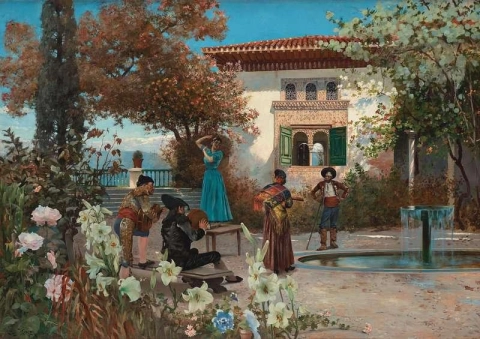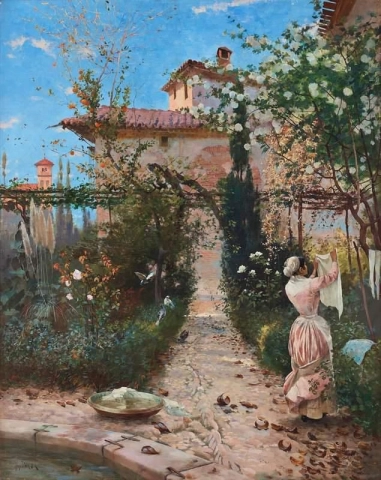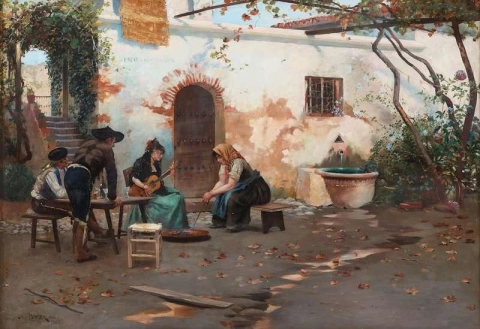

Hand painted reproductions of Hugo Birger
Hugo Birger: Renowned Swedish Painter Known for His Captivating Landscapes and Portraits
Hugo Birger (1869–1927) was a prominent Swedish painter celebrated for his impressive landscapes and insightful portraits. His works, often characterized by their precise attention to detail and evocative use of light, played an essential role in the development of Swedish art in the late 19th and early 20th centuries. Birger’s contributions to the field of art, particularly his portrayal of the Swedish countryside, have made him an enduring figure in Swedish cultural history, beloved by collectors and art enthusiasts alike.
Early Life and Education
Born in 1869 in the town of Västervik, Sweden, Hugo Birger showed an early interest in art. His family recognized his talent and supported his artistic aspirations, encouraging him to pursue formal training. Birger attended the Royal Academy of Fine Arts in Stockholm, where he honed his skills in both drawing and painting. It was during this time that he began to develop a deep appreciation for the natural world, which would become the central theme of much of his work.
After completing his education, Birger traveled extensively throughout Europe, particularly to Paris, where he encountered a diverse array of artistic movements, including Impressionism and Post-Impressionism. These influences would shape his work, providing him with the tools to create emotionally resonant landscapes that depicted nature with both realism and artistic flair.
Artistic Development and Style
Hugo Birger’s artistic style was rooted in realism, but he incorporated elements of both the Impressionist and Post-Impressionist movements into his approach. His landscape paintings, in particular, were known for their sensitivity to light and the seasons, showcasing Birger’s deep understanding of the natural environment.
Birger’s landscapes often depicted rural Swedish settings, such as lush forests, serene lakes, and expansive fields. He had a remarkable ability to capture the unique atmosphere of the Swedish countryside, using light and shadow to convey the changing moods of nature. Whether painting a sunlit meadow or a misty forest, Birger's mastery of light allowed him to imbue his landscapes with a sense of depth and emotion, creating a timeless quality in his works.
In addition to landscapes, Birger was known for his portraiture. His portraits were characterized by their detailed realism, capturing the personality and inner life of his subjects. He painted a wide range of individuals, from local figures to prominent cultural personalities, each time revealing their emotional depth through subtle gestures and expressions.
Birger's color palette was influenced by the natural environment. He often used soft, muted tones to convey the serenity of the Swedish landscape, but he was also skilled at employing richer hues when painting portraits or more vibrant scenes. His use of color, light, and texture was masterful, giving each painting a sense of life and energy.
Themes and Significance
Hugo Birger’s art was primarily concerned with the beauty of the Swedish landscape. He sought to portray nature not just as a physical setting but as a source of emotion and connection. His landscapes often reflect the themes of tranquility, change, and the passage of time, as he captured the ever-changing elements of the natural world through the changing seasons.
One of the most significant aspects of Birger’s work was his portrayal of light. He had a particular gift for capturing the interplay of light and shadow in his landscapes, whether it was the golden glow of a summer afternoon or the soft, diffuse light of an early morning mist. This sensitivity to light allowed Birger to create paintings that resonated with viewers on an emotional level, drawing them into the scene and inviting them to experience nature in a new way.
In his portraits, Birger explored the inner life of his subjects, capturing moments of stillness and contemplation. He was particularly adept at conveying the subtle emotions of his subjects, allowing their personalities to shine through in the smallest details of their expressions and posture. This ability to capture the essence of a person made Birger’s portraiture stand out from that of many of his contemporaries.
Achievements and Influence
Throughout his career, Hugo Birger exhibited widely both in Sweden and internationally. He was recognized for his exceptional skill and was highly regarded by his peers in the Swedish art community. Birger’s work was showcased in various art exhibitions, and he was a member of several prestigious artistic organizations.
Though he was not as widely known outside of Sweden during his lifetime, Birger’s work has since been rediscovered and celebrated for its emotional depth and technical mastery. His landscapes, in particular, are considered important contributions to the Swedish art tradition, capturing the essence of the Swedish countryside at a time of significant social and cultural change.
Birger’s influence on Swedish art is still felt today, as his works continue to inspire contemporary artists who seek to capture the beauty and emotional resonance of the natural world. His ability to merge realism with an expressive use of light and color has made his paintings enduringly popular among collectors and art lovers.
Legacy
Hugo Birger’s legacy as an artist is one of technical excellence and emotional depth. His landscapes and portraits have left an indelible mark on Swedish art, providing a window into the country’s natural beauty and the humanity that inhabits it. Birger’s work continues to be celebrated for its ability to evoke the emotional power of the natural world and to convey the inner lives of his subjects with profound sensitivity.
Today, Birger’s works are held in several private collections and museums, where they are treasured for their historical significance and artistic merit. His landscapes, in particular, continue to be appreciated for their timeless depiction of the Swedish countryside and their ability to capture the fleeting beauty of nature.
Where to Find Reproductions of Hugo Birger’s Art
For those wishing to bring the serene beauty of Hugo Birger’s landscapes into their homes, POD (Painting On Demand) offers high-quality oil painting reproductions. These stunning works allow collectors to experience the emotional depth and technical brilliance of Birger’s landscapes and portraits in their own space, bringing a piece of Swedish artistic heritage into the modern home.
Imagine owning an original-style painting by one of the greatest artists in history. At POD, we offer you the chance to make this dream a reality. Each canvas is faithfully reproduced down to the smallest detail, allowing you to experience the beauty of the artist’s vision in your own home.
Our reproductions are crafted by experienced painters using the finest materials and time-honored methods. We are committed to delivering works of exceptional quality that will inspire and bring joy to your family for generations to come.



























